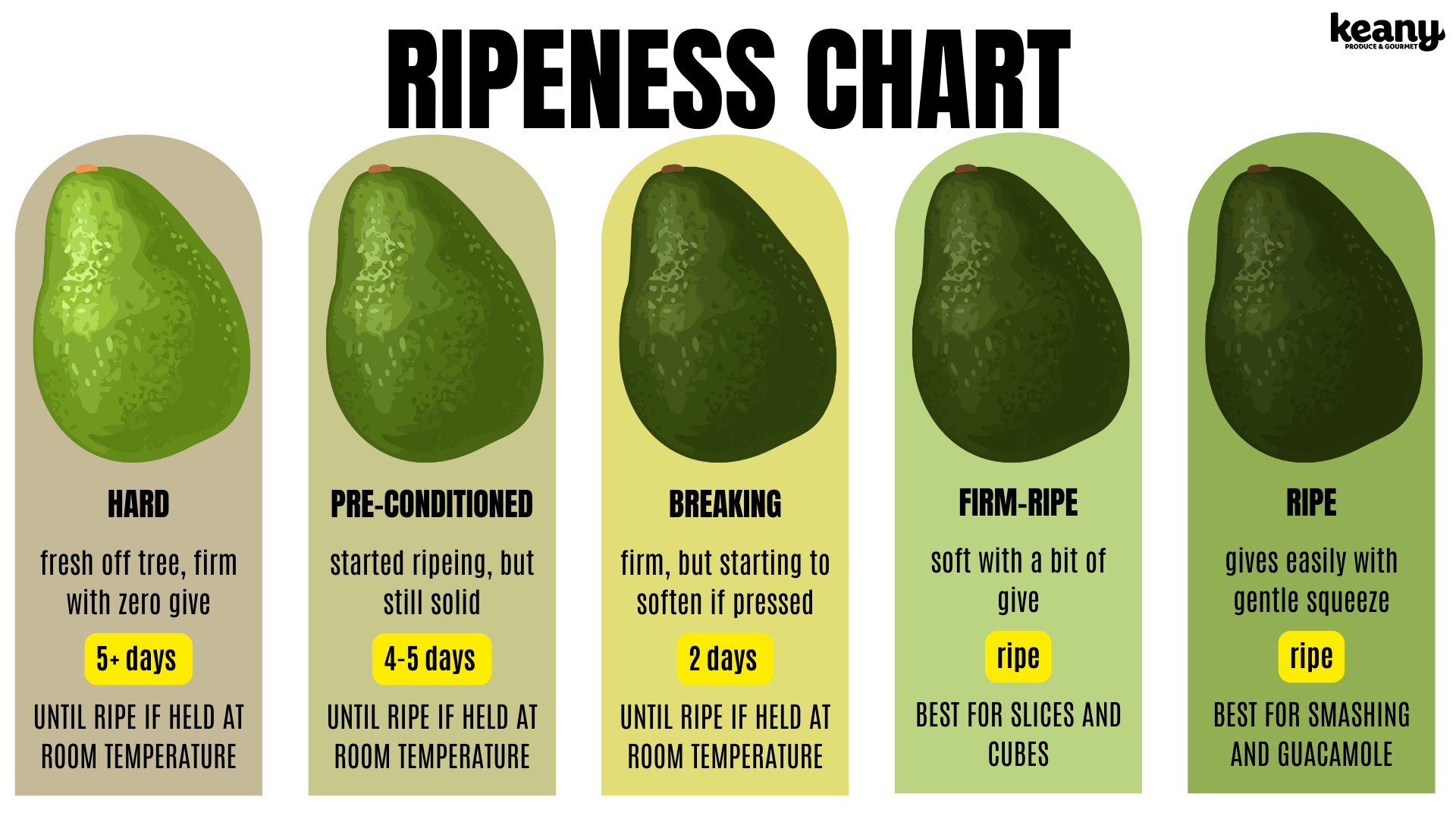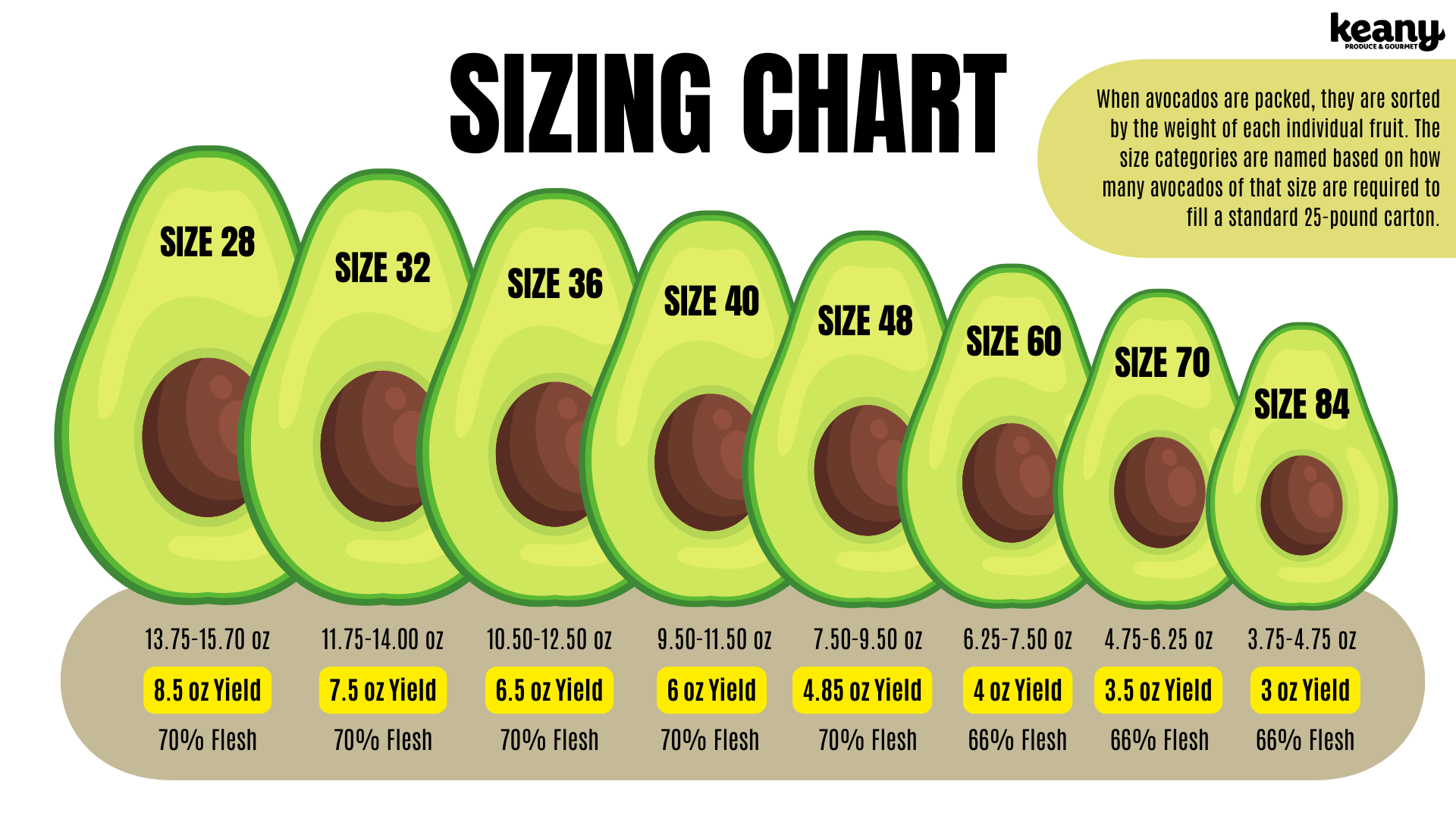
Avocado Ripening Chart – Know Your Avocados
Welcome to the avo-corner of the internet dedicated to everyone’s favorite fruit (yes, it’s a fruit!): the incredible Hass avocado! Whether you’re a guacamole enthusiast, an avo-toast lover, or simply exploring the world of avocados, you’ve come to the right place. We’re here to share everything you’ve ever wanted to know, from our Avocado Ripening Chart, Avocado Sizing Chart, to our complete Hass avocado product lineup that’s sure to leave you saying, “holy guacamole.”
What Are Hass Avocados?
Hass avocados are a beloved variety known for their unique features, delightful taste, and creamy texture. One standout feature of Hass avocados is their dark green, pebbly skin, which becomes darker as the fruit ripens, making it easy to determine when it’s ready to be enjoyed. The slightly rough texture of the skin adds to the distinct appearance of Hass avocados.
Hass avocados are rich, creamy, and buttery, with a delightful, nutty flavor that enhances any dish. The flesh is ultra-smooth and velvety, making it perfect for spreading on toast, topping off salads, or adding that creamy kick to sandwiches.
Hass avocados come in various sizes, from small to large. Typically, small avocados weigh around 4-6 ounces, medium ones weigh 6-8 ounces, and large ones weigh 8-10 ounces. The size of an avocado is based on how many fit into a standard carton, or “lug,” which holds about 25 pounds. So, a size 40 means 40 avocados fit in the lug, making them smaller in size. The smaller the number, the bigger the avocado!
At Keany Produce, we pride ourselves on offering top-quality Hass avocados, carefully selected and delivered fresh to our customers.
#1 Hass Avocados are consistent in shape, color, and quality. Ideal for presentation – halved, sliced for toast, or on a platter.
#2 Hass Avocados are less consistent in shape, color, and quality, but are still great! Ideal for guacamole, cremas, or other mixes.
- #2 Hass Conditioned Avocado – 1185 – 70 ct
- #2 CK Hass Conditioned Avocado – 1168 – 60-70 ct
- #2 Hass Conditioned Avocado – 1175 – 60 ct
- #2 Hass Conditioned Avocado – 1174 – 48 ct
Hass Green Avocados are Hass avocados that are in their first stage of ripening. Hass avocados start off with a vibrant green skin that gradually darkens to a deep purplish-black as they ripen.
Avocado scoops offer a convenient solution for adding avocado to your meals without the hassle of peeling, pitting, and slicing. They’re perfect for quick meal additions like salads, sandwiches, and smoothies, and ensure you always have perfectly ripe avocado on hand.
Leaves from the avocado tree are a culinary secret in Latin American and Caribbean kitchens. With a unique, earthy, anise-like flavor, they’re often added to Mexican dishes like stews, soups, and sauces for extra depth. Whether fresh or dried, they’re usually toasted or crushed to release their aroma, bringing out the best in meats and beans.

Avocado Ripening Chart
Avocados go through a few clear stages as they ripen, and knowing where they are in the process can help you make the most of them. The best way to know if your avocado is ready is by feeling for even softness—don’t rely on color alone. Use our Avocado Ripening Chart to help you pick the best avocado for any occasion!
What does a ripe avocado look like?

Avocados can show some color changes throughout the season. Early on, they’re usually a lighter, in-between green, and later they turn a darker shade. The early season green turns a bright green while ripening and has a slightly longer shelf life, while the late season dark green stays dark while ripening and has a slightly shorter shelf life. But no matter the time of year, they always have that signature creamy texture and delicious flavor we all love.
- Hard: Fresh off the tree, this avocado is firm with zero give – perfect for juggling but not quite for eating! It’s still about 5+ days away from being ready, so keep it at room temp and let the countdown begin.
- Pre-conditioned: This avocado has started its ripening journey, but it’s still pretty solid. Give it about 4-5 days at room temperature, and it’ll be ready to enjoy.
- Breaking: This avocado is firm but starting to soften just a bit when you press it. Give it around 2 more days at room temp, and it’ll be perfectly ripe.
- Firm-ripe: This avocado is just right—soft with a bit of give to gentle pressure. It’s ready to be sliced or cubed to perfection! They are creamy, easy to scoop, and perfect for guacamole, toast, or any dish calling for that smooth texture.
- Ripe: This avocado is at its creamy best, giving easily to a gentle squeeze. They are creamy, easy to scoop, and perfect for guacamole, toast, or any dish calling for that smooth texture.

Keany Ripening Rooms
At Keany Produce, we ensure that our avocados reach you at the ideal ripeness. Hass avocados are all about perfect timing, and that’s where ripening rooms come in! These rooms are carefully kept at a cozy 60-65°F to give avocados just the right environment to ripen to creamy perfection. We are excited to expand our facilities with additional ripening rooms, allowing us to provide even more perfectly ripened avocados, ready to meet your needs at the right time.
Avocado Sizing Chart

Hass Avocado Quality Conditions

Copper sulfate residue: Copper sulfate is commonly used in agriculture to control fungal diseases, but excessive use can leave residue on the fruit. Rest assured, it’s completely safe and harmless, with no impact on the texture, flavor, or quality of the avocado’s interior.
Hallow pit: Every now and then, you might cut into an avocado and notice something’s missing—the seed! Don’t worry, the avocado will still be just as creamy and buttery. What’s happened is the seed has dried out and turned brown, leaving a hollow spot where it used to be. There’s no problem with the rest of the fruit—it’ll ripen and taste just like any other avocado.
Ridging: Ridging refers to the presence of raised lines or ridges on the fruit’s skin. The skin is damaged at an early stage slightly stunting the young fruit; therefore it is more commonly seen in small size fruit. No worries here, ridging does not cause any damage to the inside of the fruit.
Lime Rub Scars: These brown or black spots on an avocado’s skin are just surface imperfections. They don’t affect the quality of the fruit inside. The severity of the scarring helps determine the avocado’s grade for packing.
Lenticel Spotting: Lenticels are small brown spots, usually 1-5mm, that appear on the skin of an avocado, typically after harvest and more often during the rainy season. Over time, these spots can grow and turn into larger black areas, known as spotting. Don’t worry though—lenticel spotting doesn’t affect the fruit inside. As the avocado ripens and the skin darkens, these spots tend to fade away.
Thrips Scarring: If you notice brown scars with a leathery or cabby look, they might be caused by avocado thrips—tiny flying insects that feed on immature fruit. While they don’t affect the quality inside, these visible scars can lead to downgrading or culling of the fruit.
Volcanic Ash: Avocados from southern Jalisco, near the active Colima Volcano, may have a bit of residual ash on their skin. Rest assured, it’s completely harmless and safe to eat as it is expected to ripen and taste normal.
Sunburn: Sunburn on an avocado can show up as pale yellow or darker spots, ranging from black and brown to red or withered areas. While it usually doesn’t affect the inside quality, larger sunburn spots can cause the tissue to dry out, leading to the fruit being downgraded or culled.
At the end of the day, avocados are as versatile as they are delicious, whether you’re adding them to a salad, mashing them for guacamole, or just enjoying a simple slice on toast. With so many ripening stages and differences, there’s always an avocado ready for every craving. At Keany Produce & Gourmet, we’re passionate about bringing you the freshest, highest-quality avocados, so you can enjoy their creamy goodness in every bite. Happy eating!